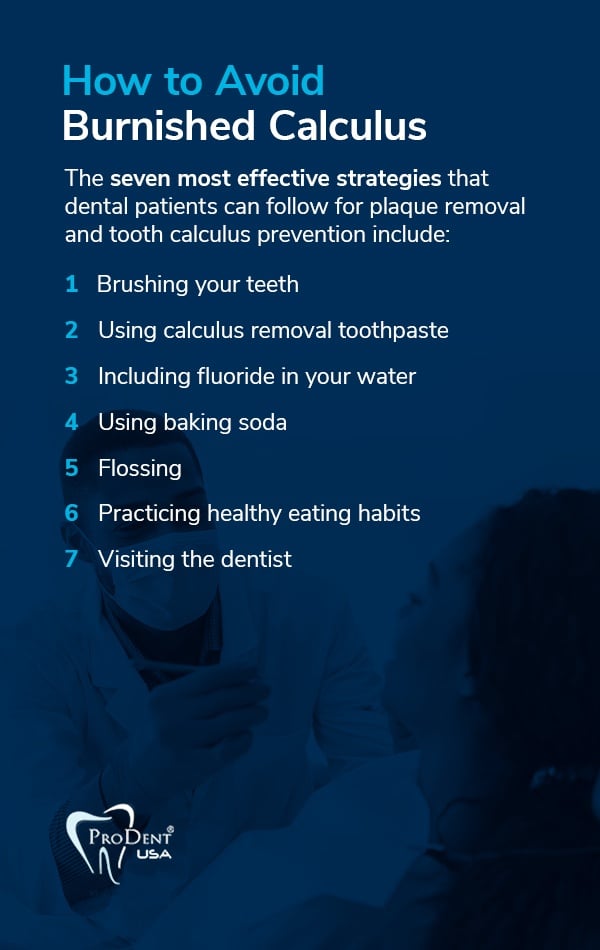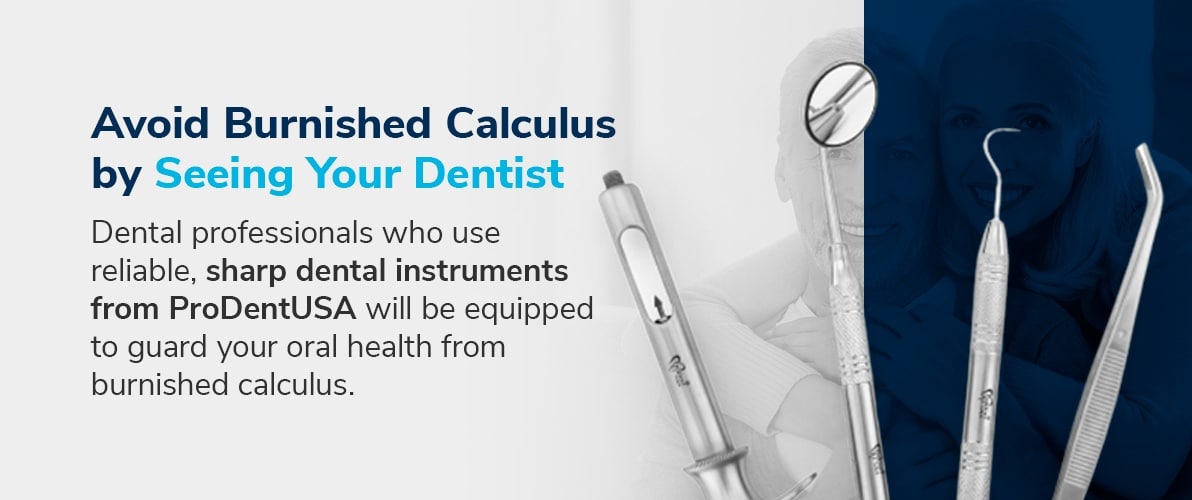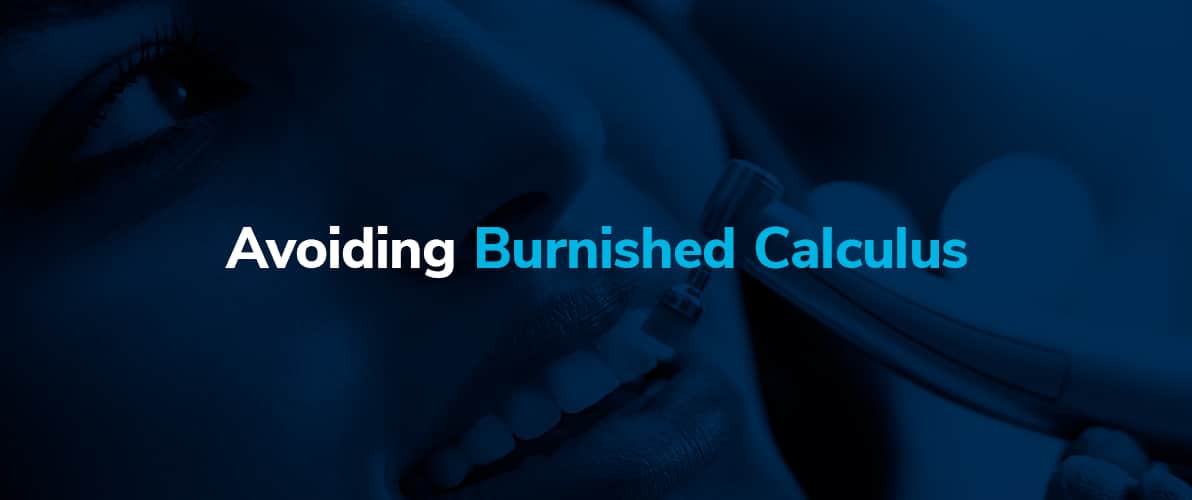Once your teeth are exposed to sticky substances and accumulate plaque, that plaque can harden and turn into a deposit on the teeth known as calculus. Burnished calculus is smooth because the outermost layer has been removed. This makes it difficult to remove the deposit because the cutting edge of the dental instrument easily slips on the deposit’s smooth surface.
Removing burnished calculus is imperative because even the smallest amount of burnished calculus can cause an ulcerated lesion in the overlying tissue, leading to a chronic state of inflammation and potential infection until the calculus is removed. Although the surface of the tooth with burnished calculus may appear smooth and pristine, the deeper layers of its calculus are still full of pathogenic biofilm.
This article discusses the causes of burnished calculus and the complications of removing the deposits, along with some burnished calculus removal tips and suggestions for preventing tooth calculus buildup. Keep reading to learn more about tooth calculus causes and how to avoid burnished calculus.

Causes of Calculus and Burnished Calculus
Unlike burnished calculus, regular calculus — also referred to as tartar — is rough and porous. Tooth calculus formation occurs when the bacteria in the mouth mixes with proteins and food residue to form a sticky film on the teeth and gum line known as dental plaque. Plaque contains bacteria that can harm tooth enamel and cause cavities. When plaque stays on the teeth too long, it can harden and become tartar.
Fortunately, removing plaque is relatively easy with regular brushing and flossing, preventing gum disease and permanent tooth decay. Calculus is more difficult to remove, so when patients go to their dentist’s office, the dental hygienist will use special tools to remove any tartar. This thorough teeth calculus cleaning process helps keep the patient’s teeth and gums healthy.
If not removed properly, tartar can lead to larger health concerns. One of the main causes of burnished calculus is dull dental instruments. A somewhat sharp hand instrument may remove the first few millimeters of a calculus deposit, but if continued scaling occurs without resharpening the blade, the instrument will become dull and start to smooth the calculus without removing the remainder of the deposit.
In addition to dull instruments, burnished calculus can be a product of dental neglect. If a clinician does not recognize or correctly remove an entire calculus deposit, the pieces left behind can form burnished calculus. This burnished calculus is most likely to be found in areas that have developmental grooves, furcations and depressions and at the cementoenamel junction (CEJ), where the enamel meets the root.
While the outermost layer of burnished calculus may be shaved off, the deposit is still attached to the tooth’s surface. Simply shaving away calculus from a tooth does not resolve the issue because it leaves the source of the irritant intact. As a deposit that has not been completely removed, burnished calculus can continue harboring harmful biofilm and causing inflammation, especially if the deposit is subgingival, or below the gums.
When left unattended, burnished calculus can worsen and result in more severe periodontal issues like gingivitis and periodontitis. These gum diseases are serious gum infections that harm the gums and can destroy the jawbone in some cases. Gum disease can also lead to tooth loss.
The Difficulty of Calculus Removal
Even for the most skilled clinician, recognizing and removing burnished calculus can be a challenge. Because a smooth veneer of calculus can cover entire portions of the root, it may be difficult for a clinician to detect and extract residual or embedded calculus. Using an explorer while scaling and root planing can help the clinician spot hidden deposits.
Here are three tips for detecting calculus:
- Assess gingival tissue: Examining the color and consistency of a patient’s gums can give clues as to whether there are underlying calculus issues. Look for discoloration and swelling — red and inflamed tissues are strong indicators of burnished calculus.
- Search for irregularities: Use a posterior explorer to feel gently for slight elevations along the teeth. Burnished calculus will feel like a smooth, raised bump.
- Check for bleeding: When using an explorer or probe to detect a grainy texture, look for any bleeding on the adjacent tissue. If there is blood after probing, burnished calculus may be present.
Once burnished calculus has been located, removing the deposit requires precise, skilled hand instrumentation with a scaler. Using short vertical or oblique strokes with the scaler can roughen the smooth burnished calculus to make removing subgingival calculus easier. Ultrasonic scaling with high-powered ultrasonic inserts/tips (UITs) can also make removing burnished calculus more manageable.
Although removing burnished calculus can be difficult, especially from a concave area like the CEJ, using the proper instruments can make an immense difference. Making sure the blade-to-tooth angle is correct is key for effective calculus removal. If the instrument’s terminal shank is not parallel to the surface being scaled, then the angulation is either too closed — less than explorer — or too open — more than 70 degrees.
Also, assess the type of deposit before attempting to remove it. In the case of heavy ledges, a high-power setting should be used. Once the ledge has been broken, the power may be lowered to continue removing the thin sheets of calculus while protecting the root surface from damage. Starting with high power is important because applying too little lateral pressure can result in burnishing.
Having sharp dental tools is also essential. If the blade being used is too dull, calculus deposits can mistakenly be smoothed instead of removed, creating more burnished calculus. Instead, use a sharp, heavy-duty instrument to break calculus cleanly away from the root so no pieces are left behind.
Dislodging the calculus by using the instrument’s point or a series of short, overlapping horizontal strokes from the edge of the deposit can effectively prevent burnished calculus. Clinicians should use slow and methodical strokes, being careful not to make the strokes haphazard. When working in a tricky area like the CEJ, using mini-bladed curettes to make horizontal strokes is a reliable technique.

Best Types of Scalers for Effective Calculus Removal
Choosing the right instrument to remove calculus is crucial because working with the wrong instrument can result in burnished calculus. For instance, if the instrument is not strong enough to remove calculus, the weak terminal shank will flex too much and only remove the top layer of biofilm. Even if the blade is sharp, it will not be able to dig deep enough into the deposit’s surface, making its calculus removal efforts ineffective and potentially causing burnishing.
This problem can be avoided by switching to a more rigid instrument. However, even a stronger dental tool will need to be checked for sharpness before use. If the blade has become worn down over time, placing too much lateral pressure on the instrument could cause it to break.
Scalers from ProDentUSA are strong, sharp and dependable dental instruments that enable clinicians to perform effective calculus extraction. All ProDentUSA products are made with reliable, long-lasting stainless steel that can stand up to tough calculus deposits. Each ProDentUSA instrument is crafted to provide the highest accuracy and precision to make removing tartar simple, even near the CEJ.
The sharpness of a ProDentUSA scaler allows clinicians to make fewer, more precise strokes to remove calculus effectively without leaving any pieces behind. More precise strokes also mean clinicians can remove calculus as gently as possible, causing minimal to no damage to the patient’s teeth and tooth roots.
Although an incorrect grasp on the dental tool can result in too little lateral pressure to grab onto the calculus, ProDentUSA scalers provide clinicians with a comfortable grip to firmly guide the instrument. By using a modified-pen grasp on the scaler, the clinician can use either their thumb or middle finger to easily push the instrument in the correct direction of the root surface being scaled.
Scalers from ProDentUSA offer a higher level of quality and durability than regular dental tools. ProDentUSA manufactures its own dental products and takes pride in the instruments it sells. All ProDentUSA instruments are backed by the ProDent Promise, which means they are designed to last and guaranteed to satisfy.
ProDentUSA also offers a Siberian Stone™ line of dental tools, which are made in the USA and come with a lifetime guarantee. These luxury dental instruments are sharp, strong and remarkably precise, enabling clinicians to remove tough calculus with extreme accuracy.
Shop Dental Scalers
Tooth Calculus FAQ
To better understand tooth calculus and how to discuss the issue with dental patients, check out these five common questions and answers about calculus:
1. What Is Tooth Calculus Made Of?
Tooth calculus is calcified, or hardened, dental plaque primarily consisting of calcium phosphate mineral salts. Dental plaque turns into calculus when its bacterial cells calcify together with the calcium phosphate that naturally exists in saliva. These tough deposits of calcified plaque cannot be brushed away and must be removed with a scaler during a dental visit.
2. Is Tooth Calculus Related to Heart Disease?
Tooth calculus and heart disease are connected because periodontal disease increases the overall burden of inflammation placed on the body, which exacerbates heart disease. Acute inflammation involves an outpouring of immune cells that attack microbial invaders and irritants to promote healing in the short term. However, chronic inflammation can contribute to numerous health problems like clogged arteries in the long term.
3. Does Tooth Calculus Stain Teeth?
As a crusty deposit on teeth, tooth calculus can trap stains underneath it, leading to discoloration. Before the underlying stain can be addressed, the calculus must be removed by a professional. If the tartar is not removed promptly, the stain could become permanent.
4. Is Calculus Removal Painful?
Multiple factors determine whether calculus removal is painful. The degree of pain experienced during calculus removal generally depends on these variables:
- Overall oral condition: If the patient has sensitive teeth, gum disease or inflammation, they will experience more pain during the tartar removal procedure than those in better oral health.
- Extent of tartar buildup: Newer tartar on the surface of the teeth is easier to remove and does not cause as much pain as tartar that has hardened over time. Hardened tartar is often stuck under the gumline, which can cause inflammation and deep aches during removal. However, this discomfort goes away after a few days.
- Tartar removal tools: The quality of the dental tools used to remove the calculus can affect how much pain a patient experiences. Using sharp instruments that allow for efficient tartar removal with fewer strokes and more precision can cut down on bleeding, gum damage and aches due to calculus removal.
- Clinician’s experience: An experienced clinician with considerable expertise can remove calculus more easily without causing the patient any significant pain.
5. Can I Remove Tooth Calculus Without a Dentist?
Because tooth calculus is a hardened deposit and often located in difficult to reach areas of the mouth, you should not attempt to remove tooth calculus on your own at home. Improperly removing tooth calculus can lead to burnished calculus and other more serious dental issues, so it is best to see your dentist for tooth calculus extraction.

How to Avoid Burnished Calculus
Although removing subgingival calculus should be left to a professional, many methods of oral care can help remove built-up plaque to prevent it from developing further. The seven most effective strategies that dental patients can follow for plaque removal and tooth calculus prevention include:
- Brushing your teeth: Of course, regularly brushing your teeth effectively preserves dental hygiene. Brushing your teeth at least twice each day can prevent plaque from hardening into calculus and becoming a larger dental issue. When you brush, make sure that you clean along the gum line and all the surfaces of your teeth, including the inner, outer and chewing surfaces.
- Using calculus removal toothpaste: While you’re brushing your teeth, you can use a calculus-control toothpaste to eliminate tartar. These types of toothpaste contain fluoride, which kills the bacteria that cause plaque. A lack of bacteria and germs also protects your teeth from cavities and decay.
- Including fluoride in your water: In addition to your toothpaste, your tap water should contain fluoride levels to aid in preventing tooth decay. Because most areas have fluoridated tap water, choosing to drink tap water instead of bottled water is a great way to ensure every member of your family gets the correct amount of fluoride. If you use a filtration system, make sure it does not filter out the water’s fluoride content.
- Using baking soda: Cleaning your teeth with a baking soda and salt mixture can help remove calculus. The mixture softens the calculus, making it easier to brush away. Simply scrub the mixture on with a toothbrush, then wash your teeth with warm water and gargle before spitting.
- Flossing: Routinely flossing removes any food particles lodged in your teeth and helps you clean parts of your mouth that are difficult to reach with a toothbrush. By removing the plaque from between teeth, flossing can help prevent calculus buildup.
- Practicing healthy eating habits: Consuming a balanced and nutritious diet is key to caring for your teeth. Foods with high calcium and protein content, such as lean meats, play a large role in protecting and strengthening your tooth enamel. On the other hand, sugary foods and beverages like candy, cookies and soft drinks can result in tooth decay. Try replacing these sweets with healthier options, such as fresh fruit and water.
- Visiting the dentist: For quick removal of tartar, you should schedule a dentist appointment. Your dentist will be able to use more advanced plaque removal processes that are both quick and effective at preventing burnished calculus. In addition, the dentist will be able to scale off any calculus that may already have formed.

Avoid Burnished Calculus by Seeing Your Dentist
At-home tooth care paired with regular dental checkups can help prevent the damaging health effects of burnished calculus. Schedule regular dental check-ups to ensure any present tartar doesn’t turn into calculus. Dental professionals who use reliable, sharp dental instruments from ProDentUSA will be equipped to guard your oral health from burnished calculus.
To learn more about how stainless steel scalers can help combat burnished calculus, contact ProDentUSA today.
Shop Dental Instruments






